

Siqi Li, Jianmin Lu, Zhipeng Huang, Shutao Xu, Chaofeng Zhang*, Feng Wang
ChemistrySelect, 2022, 7, e202203482
We present a novel method to synthesize imine and its derivatives using aromatic aldehydes and HCOONH4 without catalyst or extra additive. HCOONH4 functions as both the nitrogen source and hydrogen source. And 79.2 % yield of PhCH=NCH2Ph was obtained in 3 h at 80 °C. In addition, we propose a new continuous condensation-reduction route via the (PhCH=N)2CHPh intermediate.
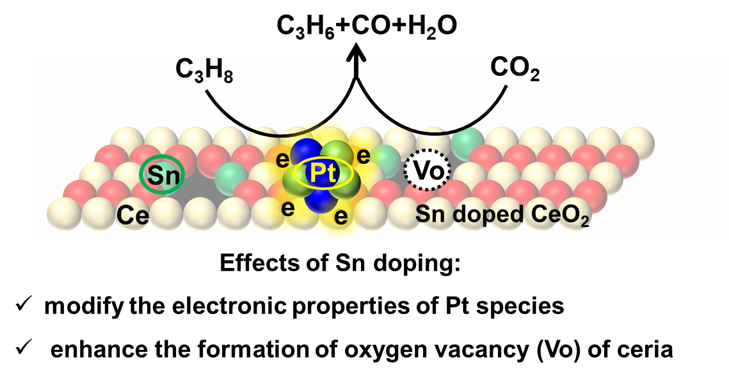
Yehong Wang*, Jiapei Wang, Yuda Zhang, Qiang Guo, Jie An, Yafei Liang, Yanan Wang, Pengfei Cao, Marc Heggen, Rafal E. Dunin-Borkowski, Xiangxue Zhu, Xiujie Li*, Feng Wang
ChemCatChem, 2022, DOI:10.1002/cctc.202200982
CO2-oxidative dehydrogenation of propane (CO2-ODHP) provides a promising route for propylene production. Sufficient propane conversion and propylene selectivity remain a great challenge due to the difficulty in activating inert propane and CO2 simultaneously. Herein, a Sn doped CeO2 supported Pt (Pt/Sn-CeO2) catalyst in CO2-ODHP reaction is reported. Sn doping appears to kill two birds with one stone for propane and CO2 activation. On the one side, it increases the electron density of Pt species via PtSn alloy formation, promoting propane adsorption and C−H bond cleavage. On the other side, it enhances oxygen vacancy concentrations of CeO2 support, facilitating CO2 dissociation. A higher propylene selectivity (63.9 % vs 22.3 %) was obtained on 0.1 wt % Pt/1.0 wt % Sn-CeO2 than that on 0.1 wt % Pt/CeO2 with a comparable propane conversion (15.1 % vs 14.3 %) at 550 °C after 240 min on stream. This work provides a reference for designing efficient catalysts.
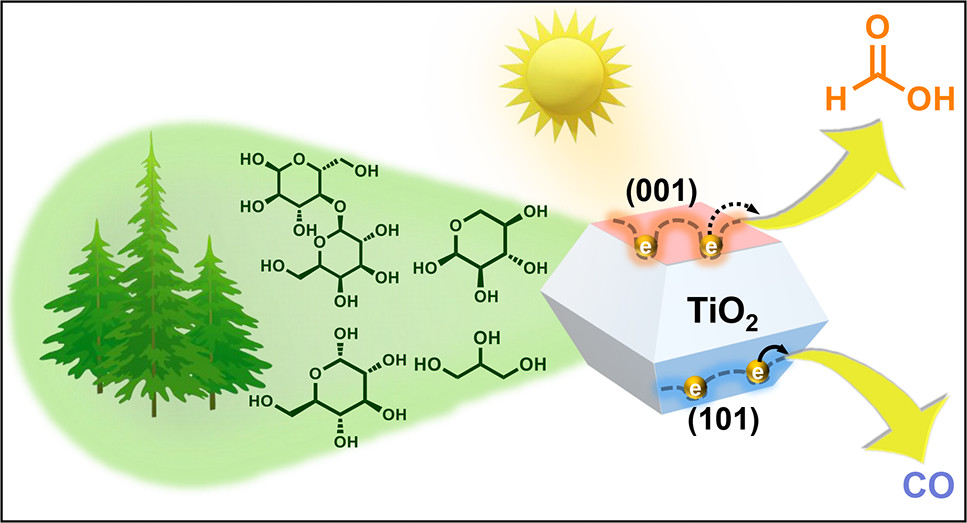
Hongru Zhou, Min Wang*, Fanhao Kong, Zhiwei Chen, Zhaolin Dou, and Feng Wang*
JACS, 2022, DOI:10.1021/jacs.2c08655
The electron transfer (ET) from the conduction band of the semiconductor to surface-bound species is a key step in the photocatalytic reaction and strongly affects the reactivity and selectivity, while the effect of catalyst surface structure on this process has rarely been explored due to the lack of an effective method. Herein, we have developed a strategy to detect and measure surface electrons’ transfer energy to the adsorbates and disclosed a facet-dependent electron transfer energy over anatase TiO2. The photogenerated electrons are shallowly confined in the five-coordinated Ti atom (Ti5c) on the surface of the (101) facet with a transfer energy below 1.0 eV, while deeply confined in the six-coordinated Ti atom (Ti6c) on the subsurface of the (001) facet with a transfer energy higher than 1.9 eV. The different electron trap states strongly affect the ET process, thus regulating the photocatalytic activity......
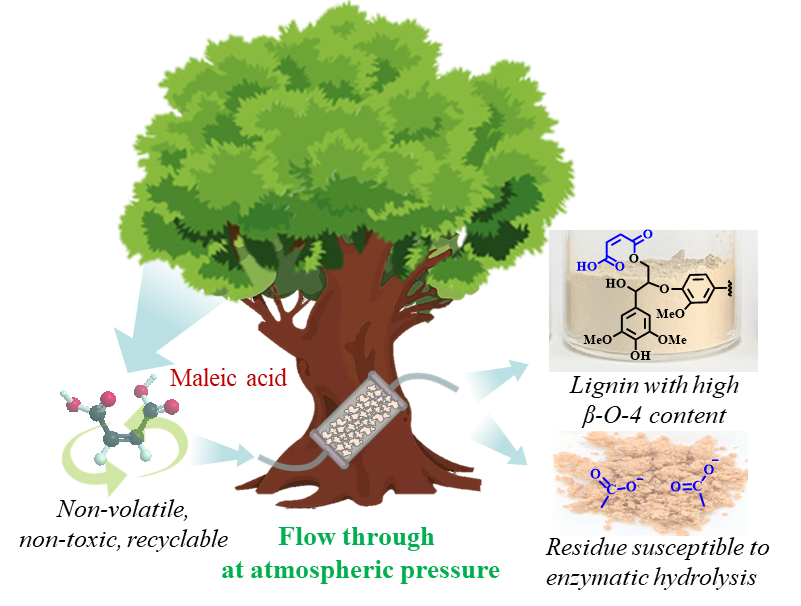
Cheng Cai, Ning Li, Huifang Liu, Jian Zhang, J.Y. Zhu*, and Feng Wang*
Chem. Eng. J., 2023, 453, 139730:1-8
Maleic acid (MA), a solid dicarboxylic acid can be obtained from renewable lignocellulose, was used to extract lignin through flow through (FT) process for the first time. Due to the high boiling point and flash point of MA, the FT process was carried out at atmospheric pressure without VOCs release and explosion risk. 50 wt% MA aqueous solution could extract 60% lignin from birch wood, and the dilution factor for precipitating lignin was only 3. MA-extracted lignin preserved more than 80% of β–O–4 bonds and a monophenol yield (>30%) comparable to that of milled wood lignin was obtained by catalytic hydrogenolysis. The recyclability of MA was demonstrated through three rounds of lignin extraction by recovered MA. And the cellulose-rich residue could be efficiently converted into glucose (glucose yield>90%) at a low cellulase loading of 10 FPU/g glucan due to the rich carboxyl groups of lignin. In addition, the …

Zhuyan Gao, Junju Mu, Jian Zhang, Zhipeng Huang, Xiangsong Lin, Nengchao Luo*, and Feng Wang*
JACS, 2022, DOI:10.1021/jacs.2c07410
Herein, we demonstrate that hydrogen bonding on the catalyst surface and in the bulk solution can inhibit oxidation and reverse reaction of α-hydroxyethyl radicals (αHRs) in photocatalytic dehydrocoupling of ethanol over Au/CdS. Intentionally added water forms surface hydrogen bonds with adsorbed αHRs and strengthens the hydrogen bonding between αHRs and ethanol while maintaining the flexibility of radicals in solution, thereby allowing for αHRs’ desorption from the Au/CdS surface and their stabilization by a solvent. The coupling rate of αHR increases by 2.4-fold, and the selectivity of the target product, 2,3-butanediol (BDO), increases from 37 to 57%. This work manifests that nonchemical bonding interactions can steer the reaction paths of radicals for selective photocatalysis.

Ying Ji, Huifang Liu, Feng Wang*, Xinwen Guo*
Catal. Today, 2022, DOI: 10.1016/j.cattod.2022.09.001
It is a green and environment-friendly strategy to use biomass to assist the synthesis of catalysts and use the prepared catalysts for biomass utilization. In this study, aluminum-rich silicon-phosphorus-aluminum nanosheet (Al-SPAN) was synthesized with biomass amino acids as additives for catalytic transfer hydrogenation of ethyl levulinate to γ-valerolactone. Compared with commercial Al2O3, Al-SPAN showed greatly improved catalytic performance for the reaction. The conversion of ethyl levulinate was increased by 47 % and the yield of γ-valerolactone was increased by 52 %. The effects of different alcohol on the reaction properties were investigated, with isopropanol used as a safe and efficient hydrogen source... ...
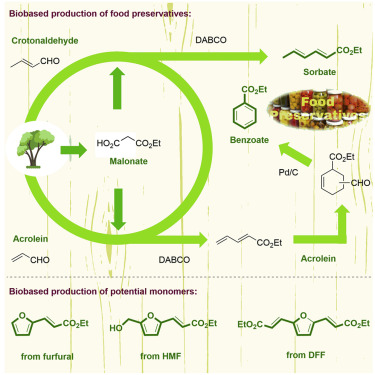
Lin Yuan, Yancheng Hu, Xin Guo, Guangyi Li, Aiqin Wang, Yu Cong, Feng Wang*, Tao Zhang*, and Ning Li*
Chem Catalysis, 2, 2302-2311
Sorbate and benzoate are the two most important preservatives used in our daily life. In industry, they are prepared from non-renewable petroleum resources. To meet sustainable development, herein, alternative routes are established with biobased malonate, crotonaldehyde, and acrolein as the feedstocks. The condensation of malonate and crotonaldehyde over the DABCO catalyst produces sorbate in a 75% yield. Acrolein is compatible with this process as well, followed by the Diels-Alder reaction and decarbonylation/dehydrogenation over Pd/C to afford benzoate in a 73% overall yield. Life-cycle assessment implies that our route has promising potential in reducing our carbon footprint. Furthermore, this work provides an interesting avenue for the synthesis of monomers with biobased furfural derivatives.
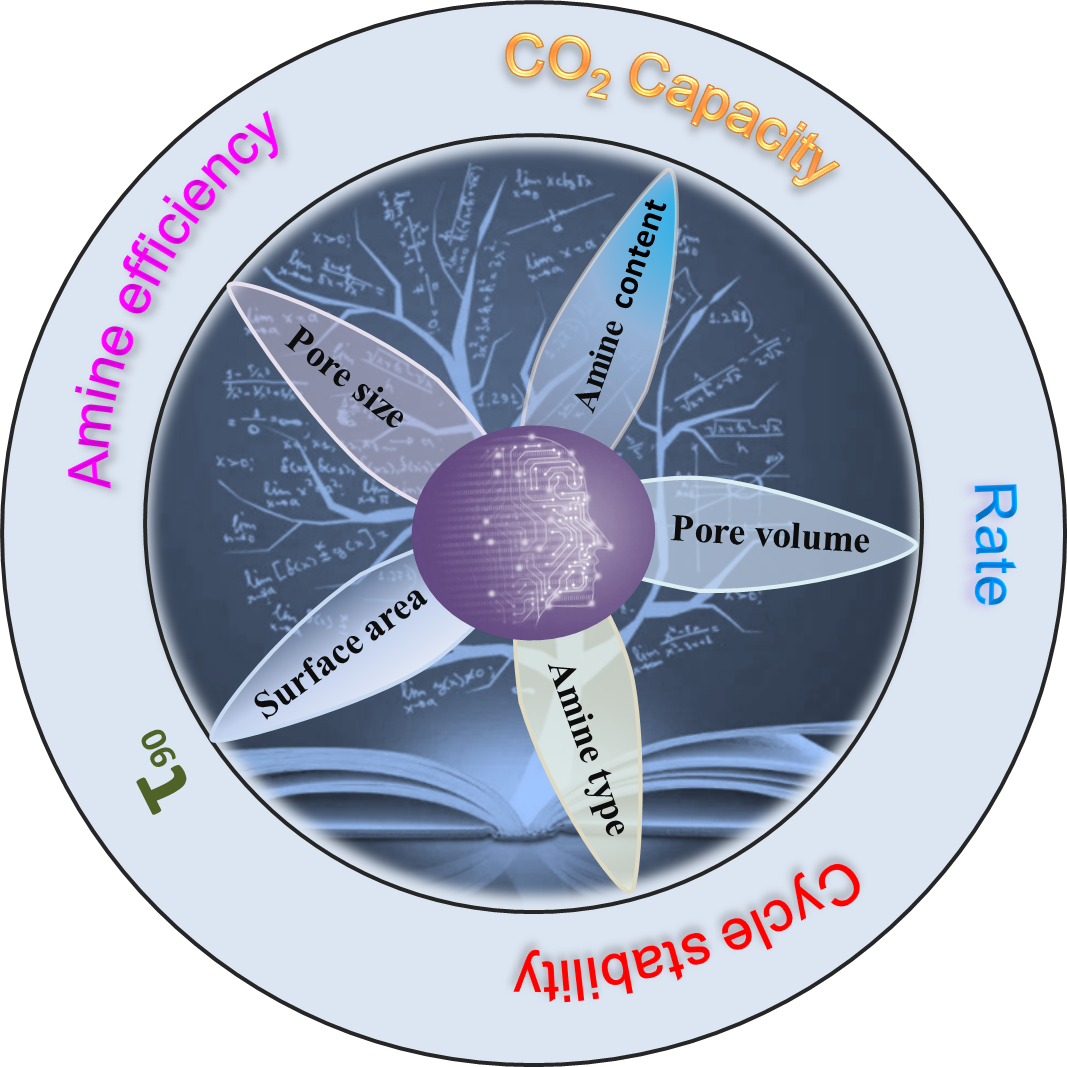
Shichao Zhang, Hang Dong, An Lin, Chaofeng Zhang, Hong Du, Junju Mu*, Jianyu Han, Jian Zhang, and Feng Wang*
ACS Sustainable Chem. Eng., 2022, DOI:10.1021/acssuschemeng.2c04492
In this work, machine learning (ML) was employed to explore how the CO2 adsorption performance of amine-functionalized adsorbents is correlated with five factors: amine loading, amine type, pore volume, pore size, and specific surface area. We found that amine loading contributed the most to the effect of CO2 adsorption capacity, followed by pore volume. Pore size was the most important factor affecting amine efficiency, while the cycle stability of the adsorbent was basically related to the amine type, and the interaction effect between the influencing factors was explored by ML. In addition, the CO2 adsorption capacities of TEPA/KXY and PEI/KYX adsorbents were predicted by ML, and the results of ML prediction were consistent with our experimental results... ...

Meijiang Liu, Huifang Liu, Ning Li, Chaofeng Zhang, Jian Zhang, and Feng Wang*
Chemsuschem, 2022, DOI: 10.1002/cssc.202201068
Photocatalysis is a promising technology for conversion of the glycerol into formic acid, but photocatalytic oxidation of C–C bonds in glycerol exhibits poor selectivity towards formic acid because the photogenerated radicals (e.g., hydroxyl radicals) further oxidize formic acid to CO 2 . In this work, we revealed a synergy of photogenerated holes and superoxide radicals that achieved the selective oxidation of glycerol into formic acid over the TiO 2 catalyst. The charge separation of pristine TiO 2 was improved with the aid of oxygen, which resulted in efficient hole oxidation of the C–C bonds in glycerol to formic acid. Surface active species were controlled to prevent being converted to hydroxyl radicals on TiO 2 via controlling the oxygen and water contents, which solved the problem of formic acid peroxidation without sophisticated catalyst modifications. Mechanism studies suggested that glyceraldehyde and glycolaldehyde were the intermediates to generate formic acid... ...
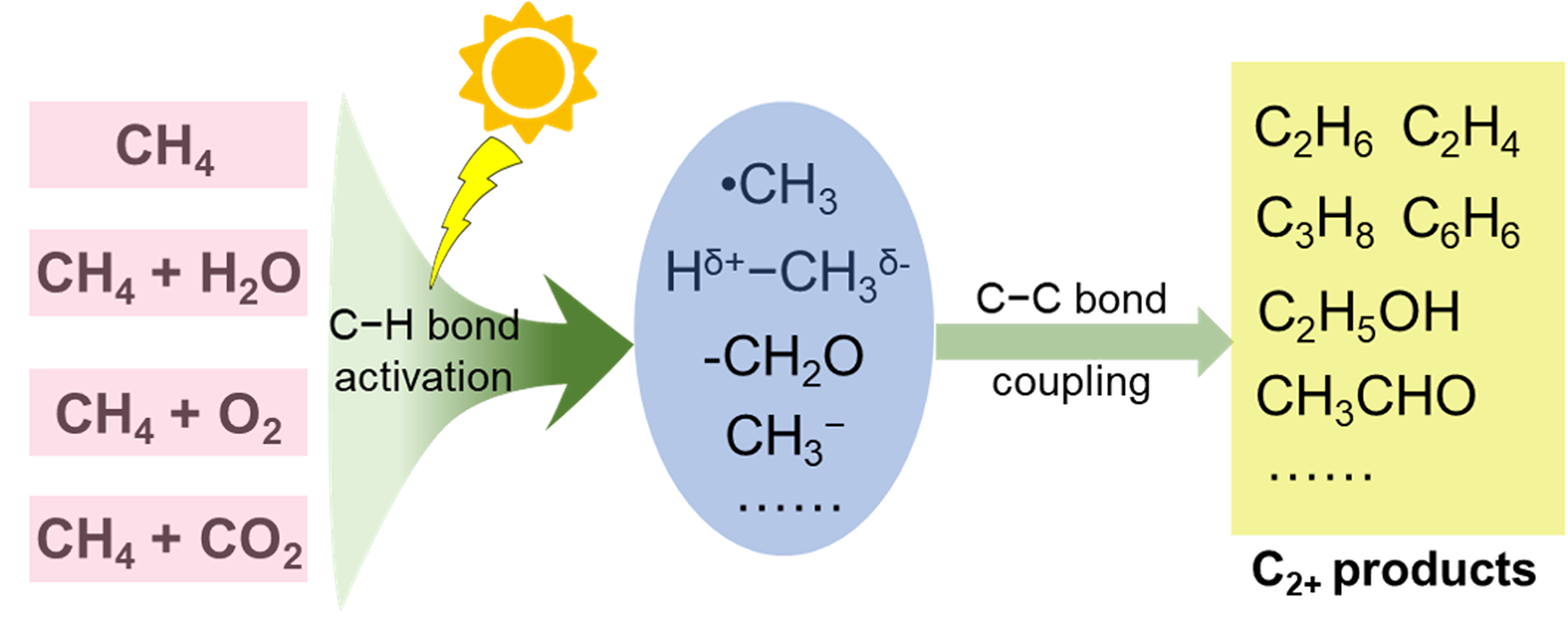
Xueyuan Wang, Nengchao Luo, and Feng Wang*
Chin. J. Chem., 2022, 12, 1492-1505
Methane, the main component of natural gas and shale gas, can be converted to upgraded fuels, syngas and value-added chemicals. Due to the nonpolar character of methane and large bond dissociation energy of sp3 C—H bond, methane conversion requires strong oxidants or acids/bases for its activation. Photocatalysis capable of inducing highly oxidative surrogates enables methane C—H bond scission at room temperature, thereby avoiding side reactions and coke formation caused by high reaction temperature. The scission of methane C—H bond generates •CH3 that may undergo C—C bond coupling with carbon radicals, which is a versatile way to obtain C2+ chemicals... ...
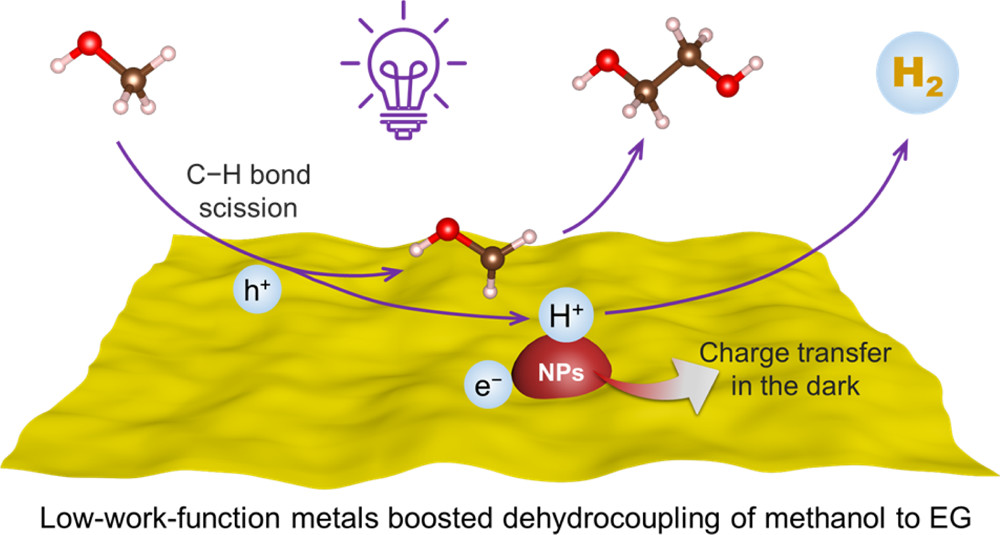
Nengchao Luo, Wei Nie, Junju Mu, Shiyang Liu, Mingrun Li, Jian Zhang, Zhuyan Gao, Fengtao Fan, and Feng Wang*
ACS Catal., 2022, 12, DOI:10.1021/acscatal.1c06005
Photocatalytic production of chemicals and fuels with H2 evolution has raised broad interest due to the carbon emission-free feature. In this context, selective and fast scission of methanol C–H bonds for coproduction of H2 and ethylene glycol (EG) over metal–semiconductor composites remains to be achieved. Here, we demonstrate that indium nanoparticles (In NPs) with a low work function (<4.3 eV) increase the selectivity and activity of ZnIn2S4 for the scission of methanol C–H bonds. By accepting electrons from In NPs, ZnIn2S4 with enriched electrons tends to activate the C–H bond instead of the O–H bond. Besides, a relatively strong built-in field is formed between In NPs and the support, which facilitates photogenerated electron transfer to In NPs for H2 evolution. Consequently, 84% selectivity of EG is obtained, and the apparent quantum yields (365 nm) of EG and H2 reach 15.6 and 27.0%, respectively.

Ying Ji, Yi Zuo, Huifang Liu, Feng Wang*, and Xinwen Guo*
ChemsusChem, 2022, DOI: 10.1002/cssc.202200747
Self-assembled spheres of silico-phospho-aluminum nanosheets were synthesized with the addition of L-arginine and evaluated as catalysts for the valorization of furfural alcohol to fuel additives. Adding the amino acid, a bio-derived additive, contributed to higher external specific surface area and more active sites, featuring a simple, environment-friendly and feasible strategy to regulate the growth of nanosheets. Herein, in the reaction of furfural alcohol with ethanol, the performance of silico-phospho-aluminum nanosheets is significantly improved compared with typical silicon phosphorus aluminum catalyst SAPO-34. The yield of ethyl levulinate with the use of silico-phospho-aluminum nanosheets was 7.8 times higher than that of SAPO-34, and meanwhile the amount of undesirable byproduct diethyl ether was decreased by two orders of magnitude and negligibly produced compared with SAPO-34... ...
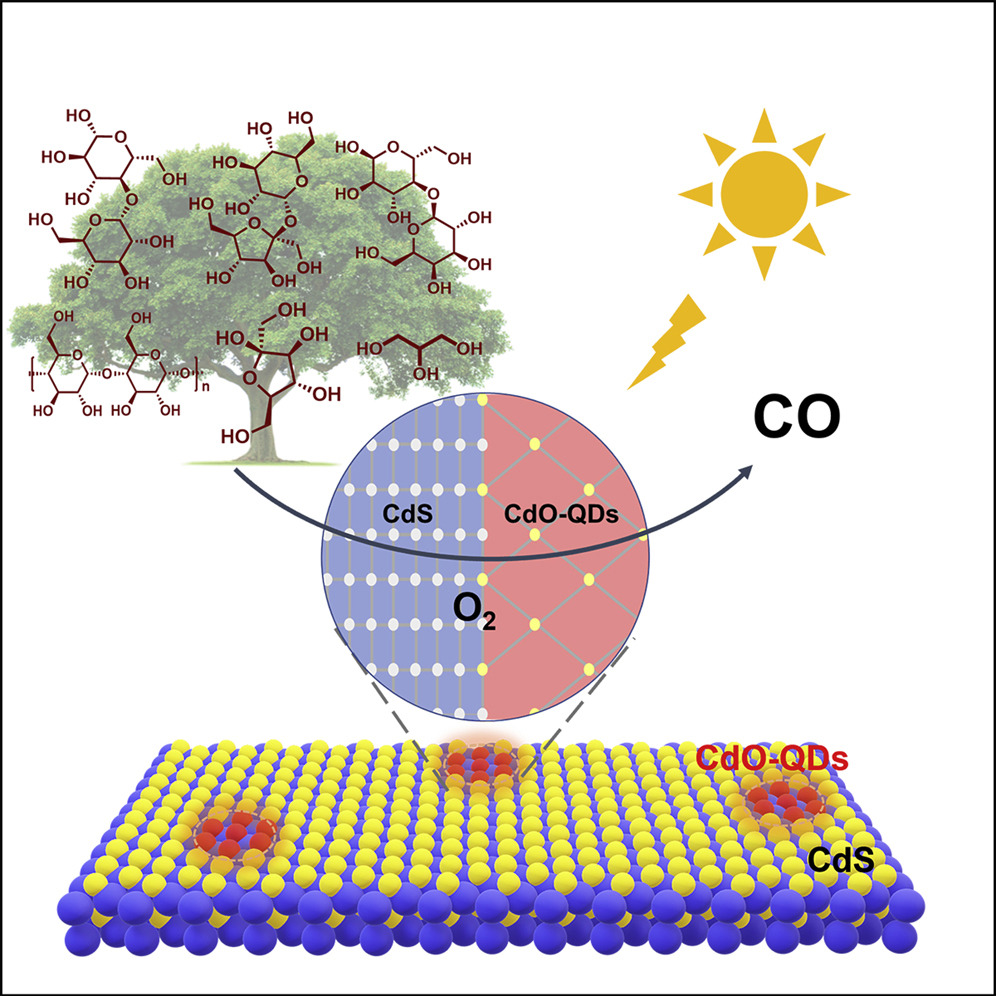
Zhe Zhang, Min Wang*, and Feng Wang*
Chem Catal., 2022, DOI:10.1016/j.checat.2022.04.001
The construction of heterojunction is effective for spatial separation of photo-induced carriers and is widely used in photocatalysis. However, owing to the poor lattice mismatch at the interface, the loose interface and the abundant of dangling bond generally constrain the interparticle migration of photocarriers. Here, we report the surface oxidative reconstruction of CdS to form CdO quantum dots (QDs)/CdS intimate heterojunction where CdS(200) and CdO(111) are tilted with a dihedral angel of 159° to form a semi-coherent interface, maximally reducing the interface dangling bonds. The semi-coherent interface and the quantum size of CdO-QDs efficiently promotes charge separation and migration to the surface, accelerating the photocatalytic bio-CO evolution. A wide range of biomass resources, even polysaccharides can be converted into CO.

Feng Wang* and Haodong Duan*
Chem Catal., 2022, 4, 644-646
Biomass is a sustainable carbon resource in nature with abundant functional groups and can be converted into chemicals and fuels, reducing carbon emissions and alleviating the energy crisis as a promising alternative to fossil fuels. However, the complex structure, abundant oxygen-containing functional groups, and robust C–C bonds of biomass make its transformation require harsh reaction conditions, which often lead to condensation side reactions, resulting in complex polymers and poor selectivity to desired products.
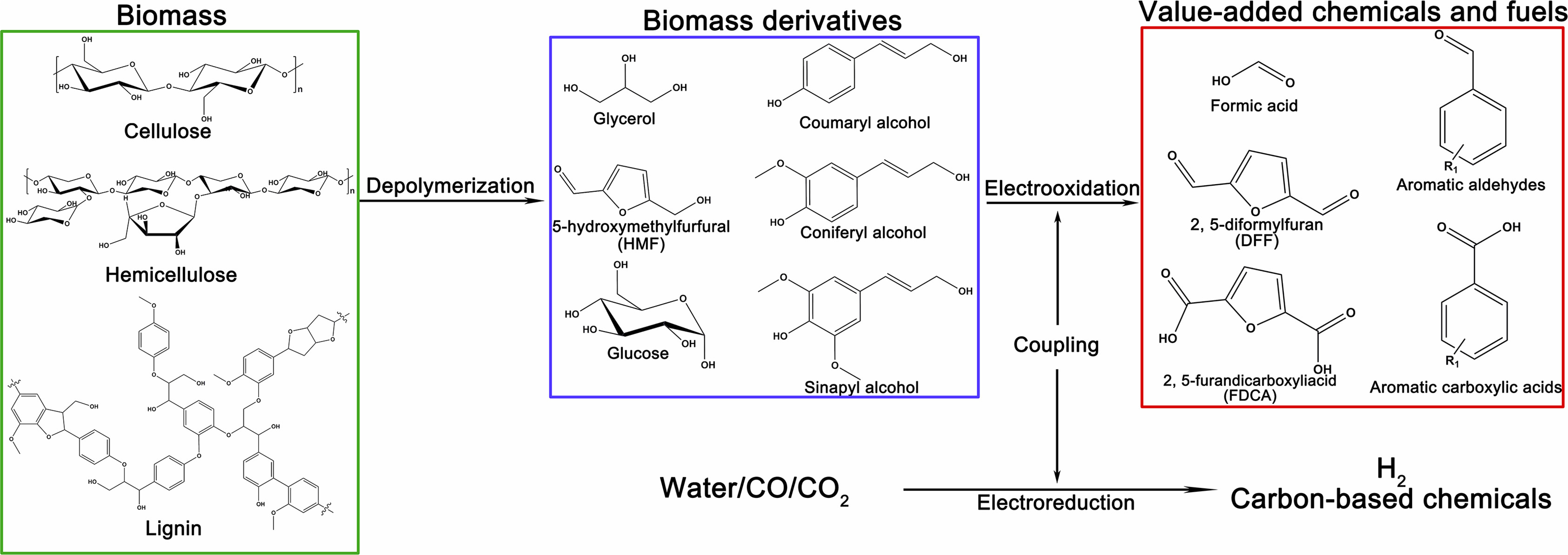
Haohong Duan* and Feng Wang*
Chem Catal., 2022, 4, 641-643
The ever-increasing consumption of finite fossil fuels (coal, crude oil, and natural gas) has caused rapidly growing carbon emissions, resulting in global warming and other environmental problems. Biomass is a promising substitute for traditional fossil fuels because of its Earth-abundant and carbon-neutral nature. Aside from the significant progress on thermal catalysis, the valorization of biomass ideally driven by renewable electricity (solar, wind, tide, etc.) has captured tremendous attention in the past decades. Other electrocatalysis benefits worth mentioning are the mild conditions (room temperature and ambient pressure) and that no external oxidants or reductants are required, so the use of toxic and environmentally unfriendly reagents can be avoided... ...
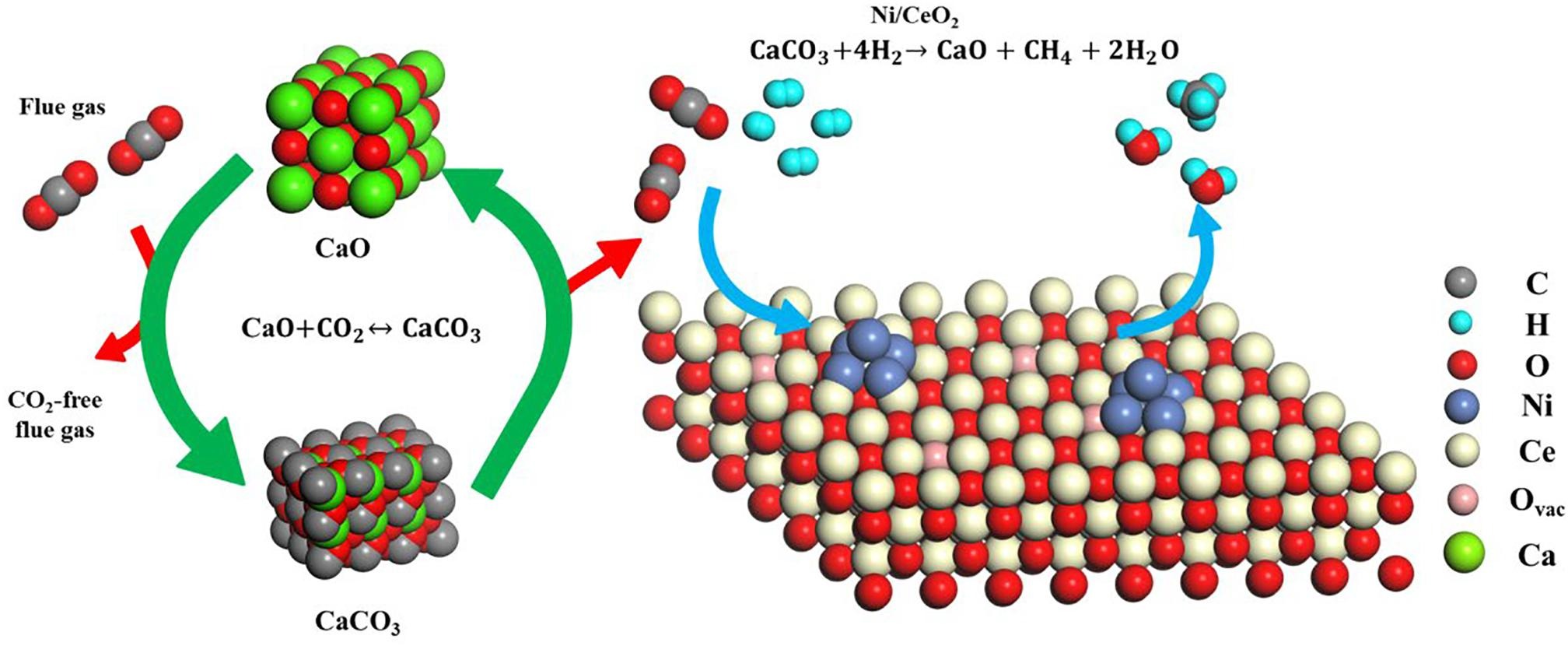
Hongman Sun, Yu Zhang, Chunfen Wang, Mark A. Isaacs, Ahmed I. Osman, Yehong Wang, David Rooney, Youhe Wang, Zifeng Yan, Christopher M.A. Parlett*, FengWang*, and Chunfei Wu*
Chem. Eng. J., 2022, 437, 135394:1-12
Integrated carbon capture and utilization (ICCU) presents an ideal solution to address anthropogenic carbon dioxide (CO2) emissions from industry and energy sectors, facilitating CO2 capture and subsequent utilization through conversion into high-value chemicals, as opposed to current release into the atmosphere. Herein, we report the synergistic coupling of porous CaO, as a sorbent for CO2 capture, and Ni doped CeO2 nanorods, as catalytic sites for CO2 reduction. It is found that ceria is shown to possess the capacity for CO2 utilization, however, critically it only results in the generation of CO due to the weak CO-ceria bonding. The addition of Ni active sites gives rise to CH4 being the predominant product, via the strong interaction between Ni species and CO, which facilitates further reduction... ...
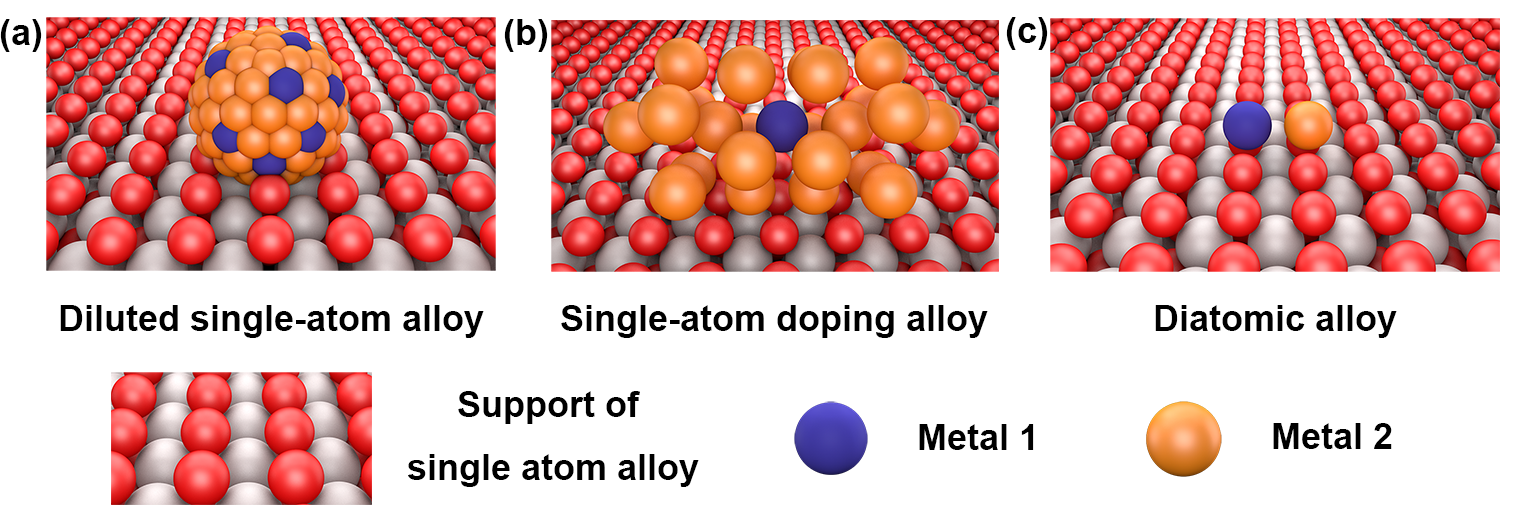
Jianyu Han,Junju Mu, and Feng Wang
Metal Single Atom Catalysis[B], 2022, DOI: 10.1002/9783527830169.ch4Supported
Single-atom catalyst (SAC) is a recently emerging frontier of heterogeneous catalysts, representing human's ability to manipulate microscopic structures. It has exhibited outstanding catalytic performances in various reactions such as alkene hydrogenation, alcohol oxidation, and electrochemical oxygen reduction. The key advantages of SACs are maximizing the utilization rate of scarce elements and enabling accurate theoretical modeling. This chapter categorizes three kinds of single-atom alloys (SAAs), namely, diluted SAAs, single-atom doping alloy, and diatomic alloy. Additionally, their preparation, characterization, and application are summarized.
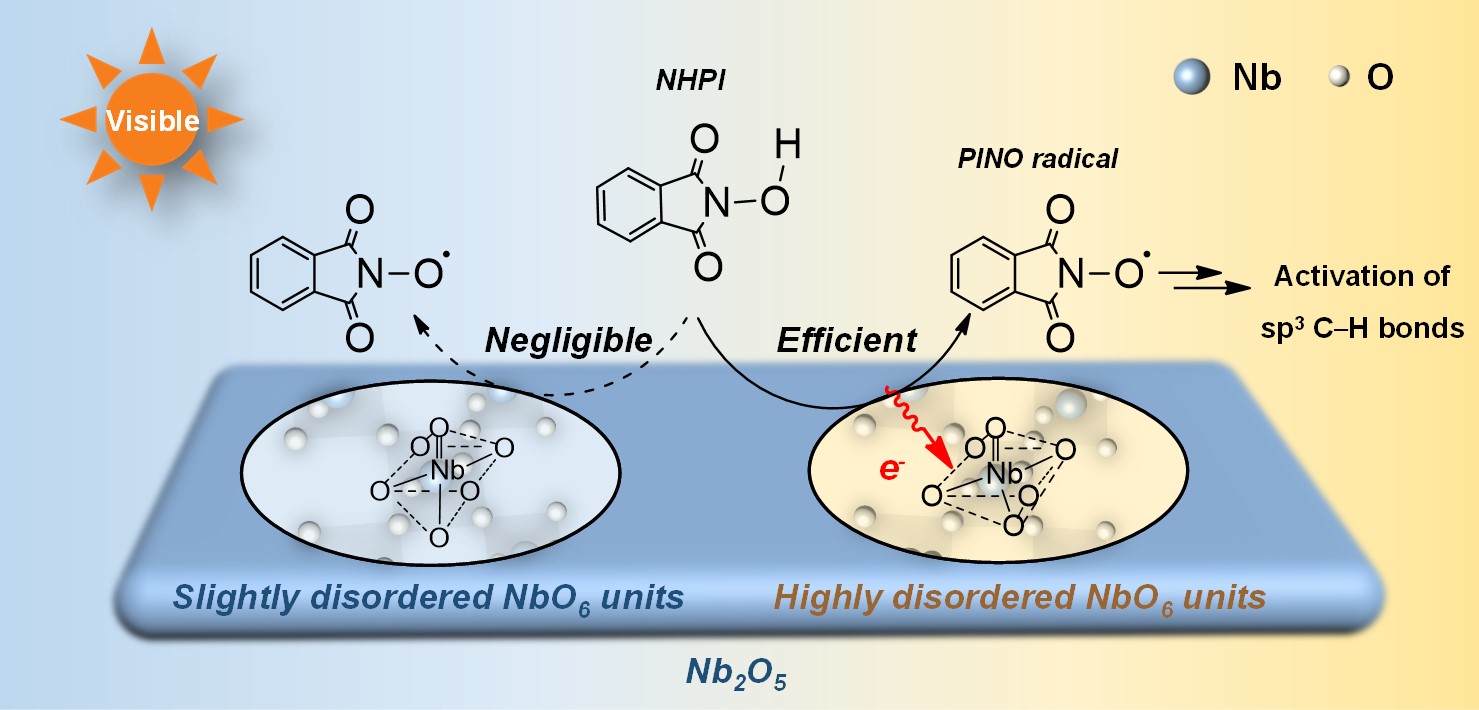
Kaiyi Su, Chaofeng Zhang*, Yehong Wang, Jian Zhang, Qiang Guo, Zhuyan Gao, and Feng Wang*
Chin. J. Catal., 2022, 43, 1894-1905
Although different NbOx units are present in Nb2O5-based catalysts, the correlations between these structures and activity remain unclear, which considerably hinders the further development of Nb2O5 photocatalysis. Herein, we utilized N-hydroxyphthalimide (NHPI) as the probe molecule to distinguish the role of different NbOx units in the activation of C-H bond under visible light irradiation. With the addition of NHPI, Nb2O5 catalysts with highly disordered NbO6 units exhibited higher activities than that with slightly disordered NbO6 units (419‒495 vs. 82 μmol·g-1·h-1) in photocatalytic selective oxidation of ethylbenzene. Revealed by Raman spectra, electron paramagnetic resonance spectra, and transmission-electron-microscopy images, highly disordered NbO6 units were confirmed to act as the active sites for the transfer of photogenerated electrons from NHPI, ...
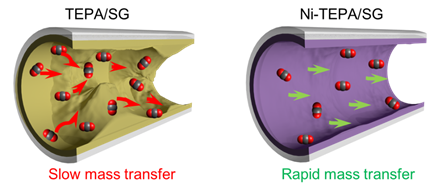
Shichao Zhang, Wenbin Chen, Junju Mu*, Jianyu Han, Chaofeng Zhang, Zhuyan Gao, Jian Zhang, Yehong Wang, and Feng Wang*
Chem. Eng. J., 2022, 436, 135211:1-9
In this work, we propose a strategy that enhances the dispersion and stability of tetraethylene pentamine (TEPA) via anchoring TEPA with single site Ni(II) in the pore of the commercial mesoporous silica gel (SG). The microscopic morphology and dynamic behavior of TEPA molecules in the adsorbents preparation process were explored by molecular dynamics simulation, which proved that the dispersibility of anchored TEPA in the porous structure has been improved, resulting in enhanced mass transfer and increased kinetic adsorption rate. The anchored Ni-TEPA/SG adsorbents exhibit a 37.5% faster kinetic adsorption rate than TEPA/SG adsorbents at 30 wt% TEPA loading, and the time required to reach 90% of maximum adsorption capacity is shortened by 6 times......

Zili Wu, Qihua Yang, Yan Liu, Boyu Zhang, Rengui Li, Wangyin Wang, Jijie Wang, Kazunari Domen, Feng Wang*, and Fengtao Fan*
ACS Catal., 2022, 12, 3063–3082
Prof. Can Li is distinguished for his seminal achievements in fundamental and applied researches in catalysis, especially in advancing the characterization of catalysts and catalytic reactions related to solar energy conversion and fine chemical synthesis. The scope of his research is wide ranging, and he is leading some of the fields. This account highlights his major scientific achievements in advancing the fundamental sciences of characterizing catalysts and understanding the mechanisms of catalytic reactions by developing in situ spectroscopic techniques (e.g., infrared (IR), ultraviolet (UV), Raman, space- and time-resolved spectroscopies and photoelectric imaging), and applying the obtained knowledge in the rational design and synthesis of catalysts for practical applications in photocatalytic, electrocatalytic and photoelectrocatalytic water splitting and CO2 reduction, chiral synthesis in nanoreactors and ultradeep desulfurization of fuels, and fine chemical synthesis.
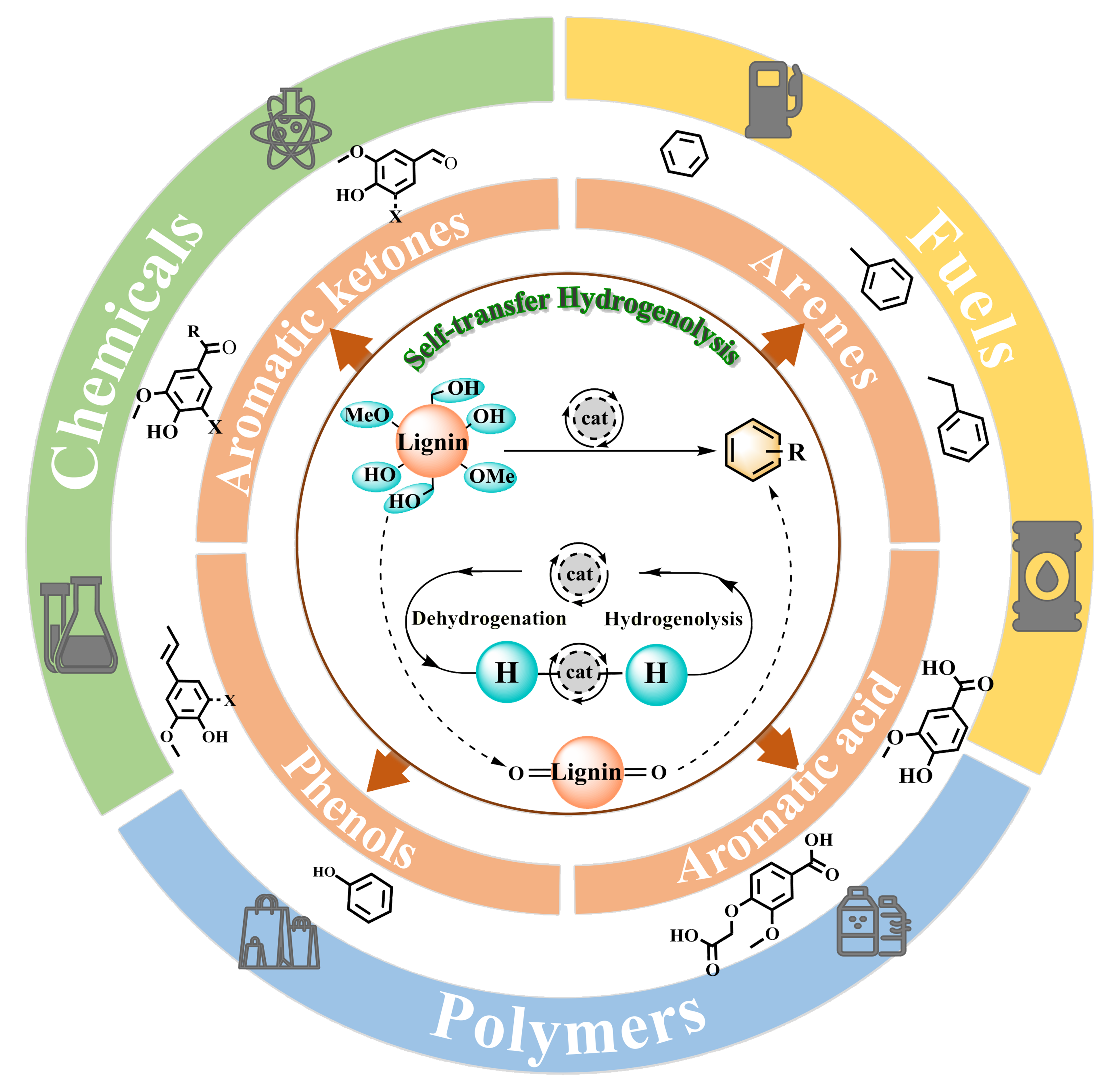
Xiaojun Shen, Chaofeng Zhang, Buxing Han, Feng Wang*
Chem. Soc. Rev., 2022, DOI: 10.1039/d1cs00908g
Plentiful aliphatic hydroxyl and methoxy groups exist in native lignin and offer a renewable alternative to H2, and can be hydrogen sources for the depolymerization and upgradation of lignin via the intramolecular catalytic transfer hydrogenation. The hydrogen source in situ generated from lignin is a type of green hydrogen, decreasing the carbon footprint. The purpose of this review is to provide a summary and perspective of lignin valorization via self-transfer hydrogenolysis, mainly focusing on a comprehensive understanding of the mechanism of catalytic self-transfer hydrogenolysis at the molecular level and developing highly effective catalytic systems. Moreover, some opportunities and challenges within this attractive field are given to discuss future research directions.
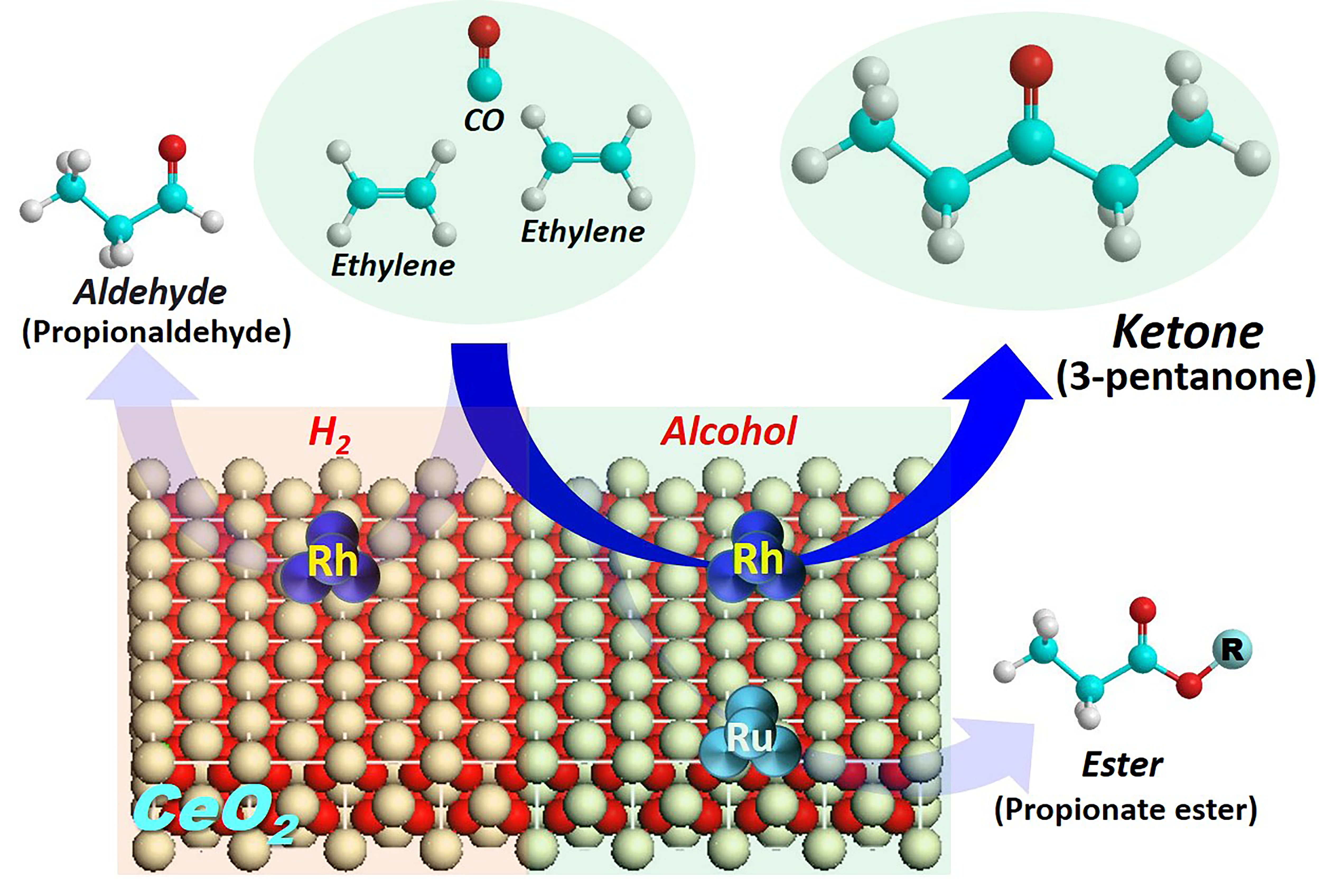
Qiang Guo, Yehong Wang, Jianyu Han, Jian Zhang, and Feng Wang*
ACS Catal., 2022, 12, 3286−3290
Herein, a promising approach to realize the ethylene carbonylation followed by C–C bond formation to produce 3-pentanone was developed by coupling with alcohol dehydrogenation–transfer–hydrogenation (DTH) reactions on a ceria-supported Rh catalyst. The interfacial Lewis acid–base pair site (Rhδ+–O–Ce3+–Ov), which is constituted by Lewis acidic Ce3+–Ov (oxygen vacancy) and basic interfacial oxygen of Rhδ+–O–Ce3+, dissociatively activates alcohol and its DTH reactions, which promotes the tandem reaction of ethylene carbonylation and C–C coupling to 3-pentanone. This route provides an alternative way to selectively synthesize higher ketones by one-step olefin carbonylation.

Yehong Wang, Jiaxu Liu, Zhitong Zhao, Qiang Guo, Qike Jiang, Ning He, and Feng Wang*
Appl. Catal. B-Environ., 2022, DOI:10.1016/j.apcatb.2022.121139
Sustainable technologies and efficient process design in chemical synthesis are in great demand for achieving a low-carbon society. Here, a sustainable approach for producing aromatics is designed via a biomass-derived carbon-negative route. A target aromatic yield of up to 50% was achieved using an industrial aqueous oxygenate mixture as the feedstocks. Such high performance is ascribed to the Zn modified ZSM-5 zeolites, which were proved to introduce synergistic catalysis involving Lewis acid sites and Brönsted acid sites, and were essential to aromatize these oxygenates efficiently. This approach provides a promising route for converting biomass-derived complex mixtures to valuable chemicals toward the carbon-neutral goal.
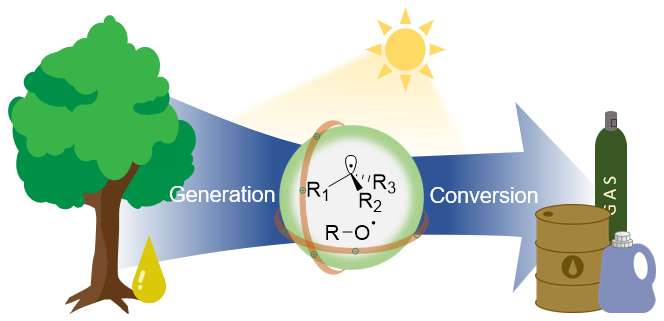
Zhipeng Huang, Nengchao Luo, Chaofeng Zhang, and Feng Wang*
Nat. Rev. Chem., 2022, DOI:10.1038/s41570-022-00359-9
Photocatalysis is an emerging approach for sustainable chemical production from renewable biomass under mild conditions. Active radicals are always generated as key intermediates, in which their high reactivity renders them versatile for various upgrading processes. However, controlling their reaction is a challenge, especially in highly functionalized biomass frameworks. In this Review, we summarize recent advanced photocatalytic systems for selective biomass valorization, with an emphasis on their distinct radical-mediated reaction patterns. The strategies for generating a specific radical intermediate and controlling its subsequent conversion towards desired chemicals are also highlighted, aiming to provide guidance for future studies. We believe that taking full advantage of the unique reactivity of radical intermediates would provide great opportunities to develop more efficient photocatalytic systems for biomass valorization.
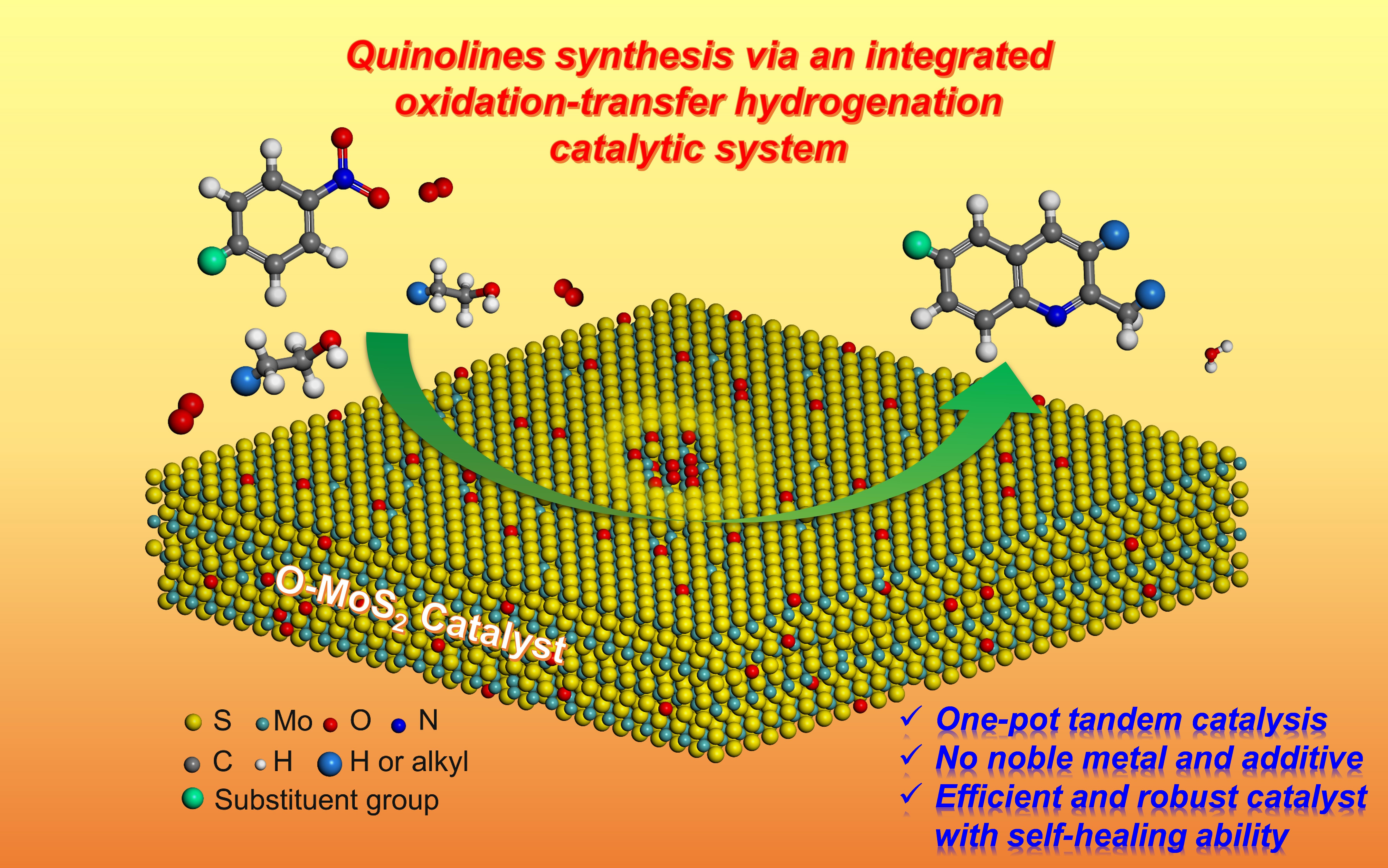
Chaofeng Zhang*, Zhuyan Gao, Puning Ren, Jianmin Lu, Zhipeng Huang, Kaiyi Su, Shichao Zhang, Junju Mu, and Feng Wang*
Green Chem., 2022, DOI:10.1039/D1GC04058H
We herein report that the MoS2 with oxygen-implanting modification (O-MoS2) can work as a multifunctional catalyst to achieve the one-pot quinolines synthesis from basic nitroarenes and aliphatic alcohols. By overturning the catalysis cognition that O2 adsorption on MoSx can deactivate the MoS2-based catalysts to an efficient method for in-situ healing the MoOx structure in O-MoS2 and protecting the O-MoS2 catalyst by inhibiting unwanted MoOx elimination with extra H*, we innovatively introduce O2 in the quinoline synthesis. The robust O-MoS2 can be consecutively used ten times without regeneration and keep offering 69~75% yields of 2-methylquinoline from nitrobenzene and ethanol. Furthermore, different from the traditional transfer hydrogenation-condensation mechanism, an integrated oxidation-transfer hydrogenation-cyclization mechanism is proposed over the O-MoS2 catalyst.
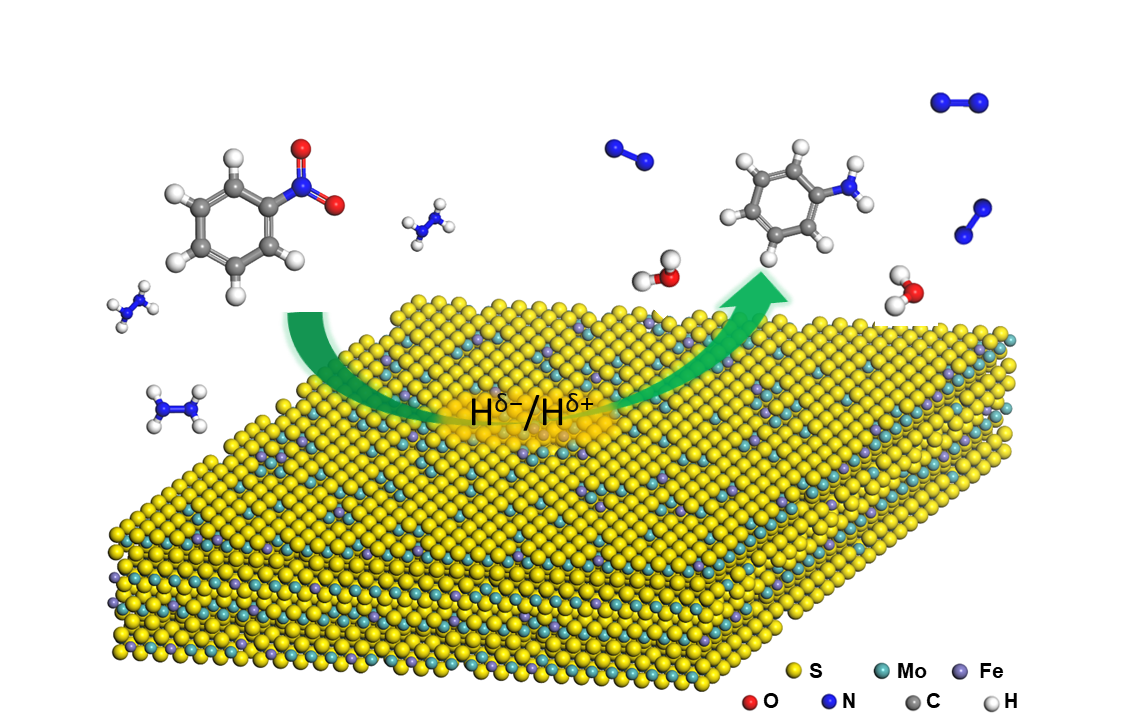
Siqi Li, Zhipeng Huang, Huifang Liu, Meijiang Liu, Chaofeng Zhang* and Feng Wang
Dalton Trans., 51, 1553-1560
We herein present an efficient approach for the chemoselective synthesis of arylamines from nitroarenes and hydrazine over an iron-molybdenum sulfide catalyst ([FeMo]Sx). The heterogeneous hydrogen transfer reduction can be efficiently carried out at 30 °C and provides anilines with 95–99% selectivities. The in situ gas product analysis demonstrates that [FeMo]Sx can catalyze the decomposition of N2H4 to H* species, not H2. Combining with the kinetic analysis of the aniline generation rates from nitrobenzene and intermediates, the nitro group reduction to the nitroso group is confirmed to be the rate-determining step. The positive slope of Hammett's equation suggests that the critical intermediate in the rate-determining step is in the negative state, which suggests that the active H* should be in polar states (Hδ− and Hδ+). These findings will provide a novel route for the synthesis of substituted anilines and broaden the application of MoSx catalysts under mild conditions.
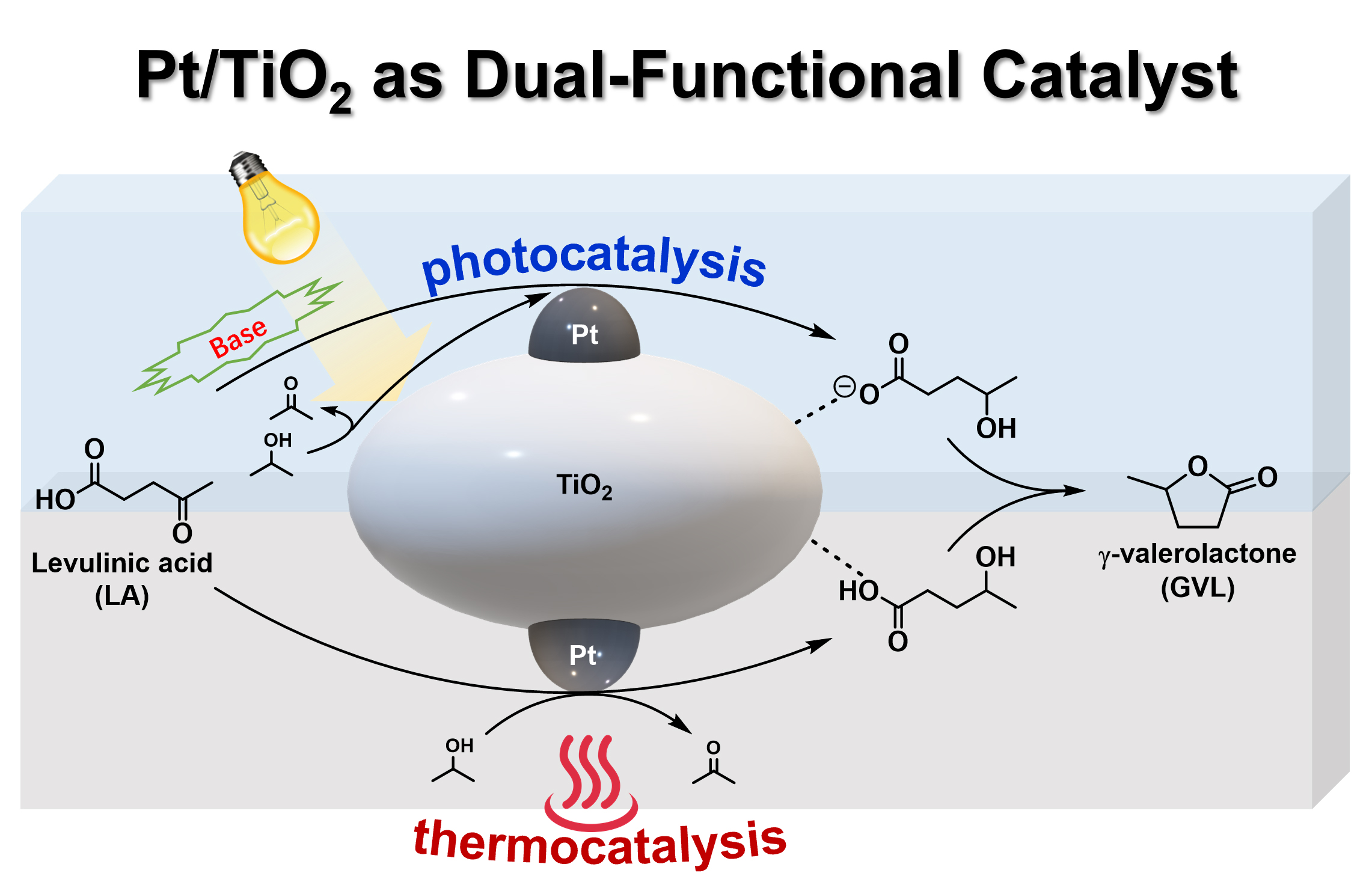
Anon Bunrit, Teera Butburee, Meijiang Liu, Zhipeng Huang, Keerati Meeporn, Chaiyasit Phawa, Jian Zhang, Sanchai Kuboon, Huifang Liu, Kajornsak Faungnawakij*, and Feng Wang*
ACS Catal., 2022, 12, 1677-1685
Herein, we developed photo–thermo-dual catalytic strategies for the production of γ-valerolactone (GVL) from levulinic acid (LA) and its ester using platinum-loaded TiO2 as a dual-functional catalyst. Both catalytic systems were evaluated under mild reaction conditions. In the photocatalysis system, a base plays crucial roles in the conversion of LA and EL to GVL. The control experiments reveal that plausible mechanistic pathways of both systems proceed via the hydrogenation of the ketone group of LA to the corresponding alcohol as a major intermediate followed by a subsequent cyclization step to GVL. This dual-functional catalyst provides alternative strategies for the conversion of LA and its ester into GVL, which could pave the way for biomass utilization in a more effective and practical manner.
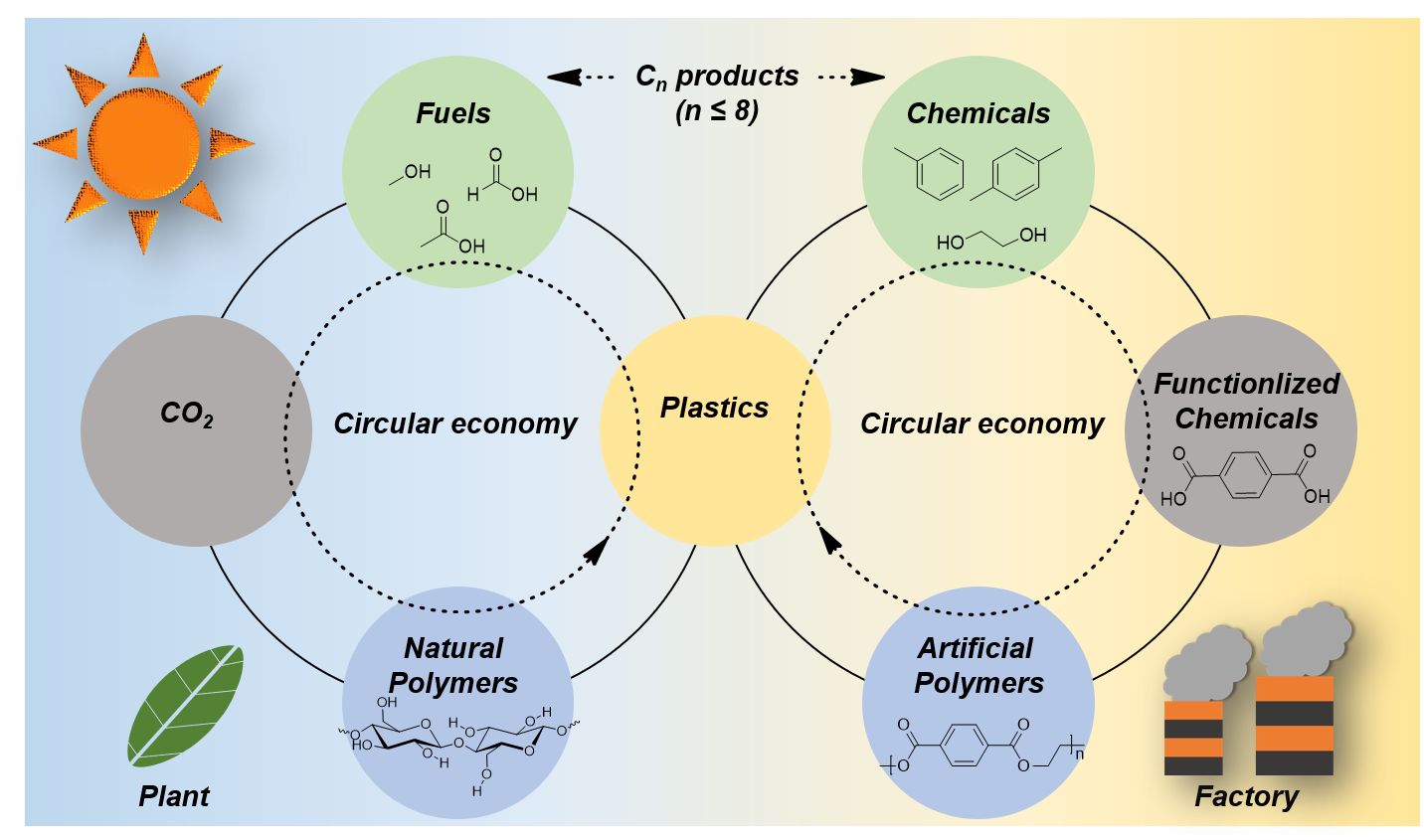
Kaiyi Su, Huifang Liu, Chaofeng Zhang, and Feng Wang*
Chin. J. Catal., 2022, 43, 589-594
As a great threat to all livings on earth, waste artificial plastics now are everywhere, from oceans to our cells. The world cannot withstand the growing waste plastic in million tonnes every year, which has already caused environmental pollution and economic losses. Besides the efforts for preparing novel plastics with the self-decomposition ability, the world needs methods to clear away these waste plastics leftover from history or recycle well this organic carbon resource. Photocatalysis is a potential solution for the conversion of waste plastics under mild conditions. In this perspective, we highlight the effect of photocatalytic approaches toward the generation of low carbon number organic products (Cn products, n ≤ 8) from waste plastics, which can proceed under an inert or aerobic atmosphere. Notably, critical analysis of the carbon source in products is necessary to reveal the active species for the C–X bonds (X = C, N, and O) cleavage of plastics... ...